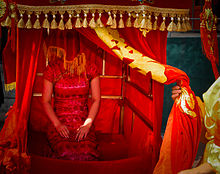


Traditional Chinese wedding dress is a collective term which refers to all the different forms and styles of traditional wedding attire worn by the Han Chinese when performing their marriage ceremony, including the traditional Chinese marriage.[1] There are various forms of traditional Chinese wedding dress in the history of China.[2] Since the Zhou dynasty, there have national laws and rules which regulated the different categories of clothing and personal accessories; these regulations have created various categories of clothing attire, including the traditional wedding attire of the Chinese people.[3]: 3

The cheongsam (Chinese: 旗袍), or zansae also known as qipao, sometimes referred to as the mandarin gown, traces its origins to the Qing dynasty.[4] Cheongsam was the dress for Manchu women which become popular in Hong Kong and Shanghai after the fall of the Qing dynasty in 1912.[5] Nowadays, the cheongsam can also be worn as a wedding dress.[2]

The fengguan xiapei (Chinese: 凤冠霞帔) is a type of wedding set of attire categorized under Hanfu. It was worn in Ming and Qing dynasties.[6] The fengguan xiapei attire was composed an upper and lower garment following the traditional yichang system.[7]
In the Qing dynasty, it was composed of an ao, a type of upper garment, called mangao (Chinese: 蟒袄; lit. 'python jacket') and a qun, lower skirt, called mangchu (lit. 'python skirt').[8]
The mangao was a type of yuanlingshan fashioned in the style of the Ming dynasty which was red in colour; it used to be worn by the Han Chinese women as a court robe.[8]
The mangchu was a qun which could either be red or green in colour; it was embroidered with dragons and phoenixes on the front and back lapel of the skirt.[8] The two accessories items from which the set of attire of gained its name was the fengguan, which was a type of guan, and the xiapei (Chinese: 霞帔).[8]
The appearance of the xiapei appearance and construction differed depending on the time period: in the Ming dynasty, the xiapei was similar to a long scarf or stole in appearance; however, it became a type of waistcoat in the Qing dynasty.[8] The fengguan xiapei was sometimes adorned with the yunjian.[8] Following the wedding ceremony, married women were expected to wear the fengguan xiapei on formal occasions, however, Chinese trousers or leggings were worn beneath instead of the skirt.[8]

The qungua, also commonly known as longfenggua, guaqunorlongfeng qungua is a set of attire which follows the traditional yichang system. It is a composed of a jacket called gua (Chinese:褂) and a long qun (Chinese:裙) which could be straight in cut[9] or have pleated sides.[10]
The tradition of wearing the qungua as a wedding dress originated in the Qing dynasty during the 18th century.[11] Initially, the qungua was sewn by the mother of the bride as soon as the bride was born due to the time-consuming process of the handcraft; it would then be given later on as the part of the bride's dowry from her family when she would get married. There are 5 different types of qungua (Guahuang, Guahou, Dawufu, Zhongwufu, Xiaowufu) which are based on the amount of embroideries which were crafted on the dress.[12] Nowadays, the qungua has been commercialized and remains a popular form of wedding dress.[12]
The Xiuhefu (simplified Chinese: 秀禾服; traditional Chinese: 繡和服) is a set of attire which follows the traditional yichang system; it is a composed of a waist-length liling dajin ao and a long A-line qun, which looks similar to a mamianqun.[9] The Xiuhefu is typically embroidered with flowers and birds to symbolize love for whole seasons.[6]
The precursor of the Xiuhefu can be traced back to the Qing dynasty where a Qing dynasty-style aoqun, consisted of liling dajin changao and a mamianqun, was worn as a form of wedding dress during this period.[6] What is currently known as the Xiuhefu became popular in 2001 when Zhou Xun, the actress who played the role of Xiu He, wore a modern recreation version of the Qing dynasty wedding aoqun in the Chinese television drama Orange turned red (Chinese: 橘子紅了) thus gaining its contemporary name from name of the character, Xiu He.[6][13]
{{cite book}}: CS1 maint: location missing publisher (link)
|
| |||||||||||||||||||
|---|---|---|---|---|---|---|---|---|---|---|---|---|---|---|---|---|---|---|---|
| Characteristics |
| ||||||||||||||||||
| Garments |
| ||||||||||||||||||
| Headwear (list) |
| ||||||||||||||||||
| Footwear (list) |
| ||||||||||||||||||
| Accessories (list) |
| ||||||||||||||||||
| Influenced clothing |
| ||||||||||||||||||
| Cosmetics |
| ||||||||||||||||||
| |||||||||||||||||||